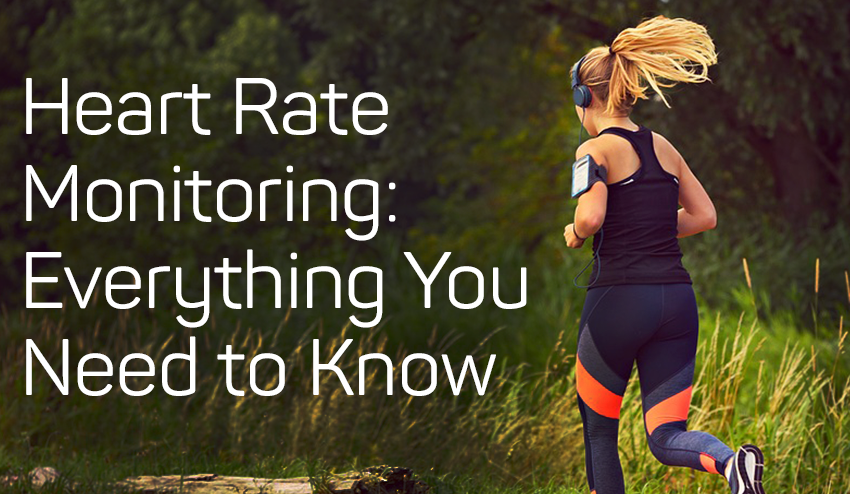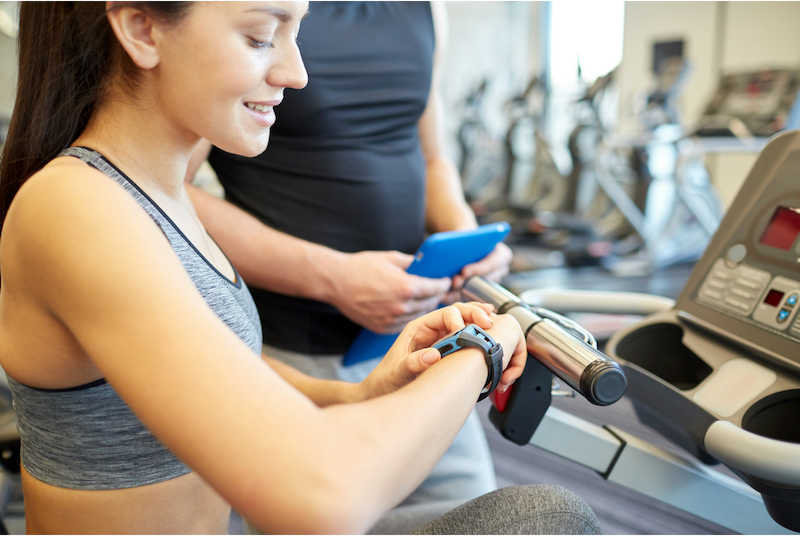
Why Monitor Your Exercise Intensity?
To get the most out of your workout, you should frequently monitor your exercise intensity by knowing your heart rate. This will ensure that you are working within the proper heart rate training zone and getting the most out of each workout. If you are always working to your max heart rate, you're likely to injure yourself and will burn out very quickly. On the other hand, if you never break a sweat you may get frustrated when you don't see results over time. The solution? Find the proper balance of working in a moderate intensity and pushing yourself to your higher limits. There are a few different ways to monitor your exercise intensity.How to Monitor Your Exercise Intensity
1. Take Your Pulse
The simplest way to monitor your heart rate is to take your own pulse. To do this, place your index and middle fingers directly under your ear, then slide your fingers down until they are directly under your jawbone, pressing lightly. Start with zero on the first beat and count for 10 seconds then multiply by six. Always check your pulse frequently throughout your workout to make sure you’re within your target heart rate zone (chart below). Of course, while this method is simple and cheap, it is not always easy to continue feeling for your pulse and counting while you are also trying to work hard.2. Get A Heart Rate Monitor
A much easier and quicker way to get heart rate feedback is to wear a heart rate monitor. Heart rate monitors do the work for you, counting and tracking your heart rate throughout your workout. These days, the options are endless, but the below heart rate monitors are our favorites: Fitbit: Fitbits come in a wide variety of models from simple to high tech. Their cheaper models simply track the steps you take in a day whereas their higher tech models give you heart rate tracking, cardio fitness, calories and sleep tracking feedback. So, depending on what you’re looking for, you can make a selection based on your needs. Apple Watch: This watch was designed for the tech lover and fitness enthusiast. It comes with a bit of a steeper price tag, but also has more capabilities outside of just exercise-related features (this is what Chris Freytag uses and loves). While at first the Apple Watch lacked a bit in accuracy, the newer models are getting better all the time. The nice thing is that the activity app on the watch reminds you to stand if you sit too much, gives feedback on the days you might need a workout reminder, and lets you know both heart rate and how many calories you burn in your workout. Polar USA: This is the most recognized name for heart rate monitors in the fitness world. And for good reason! Polar gives a quality, accurate product. They offer everything from basic to high tech and their website does a nice job describing the features on each watch. Garmin: Garmin is known for its GPS capability, but they also make products that track your heart rate. This is another product with a user-friendly website so check them out for options.Where Should My Heart Rate Be?
Now that you know how to find your heart rate, let’s talk about what heart rate zone you should be aiming for? First things first: figure out what your maximum heart rate, or “MHR”, is. Your MHR will help you discover where your training zones are.Finding My Maximum Heart Rate
Finding your MHR is a smart idea because your target heart rate zones will be determined based on this number. For this number you can use something called the Karvonen Formula. Karvonen Formula: If you hate math, don’t freak out! It’s incredibly simple. Just take the number, 220 and subtract your age from it to find your MHR. Example: if you are a 40-year-old woman, your MHR is 180 (220-40=180). That means if your heart rate monitor says 180, you are working at 100% effort. If it says 90, you are working at 50% effort. You’ll see what these percentages mean in a moment. One thing to consider with the Karvonen Formula is that [220-your age] covers the general population. Of course, since we are all unique with different sized hearts and different health considerations, you can probably guess that this number won’t be exactly customized to you. If you’re looking for an ever more accurate number for your, heart rate testing is also an option. Heart Rate Testing: You can also get your MHR checked in a more accurate way by finding a gym or trainer who performs heart rate testing on you. For this test, you will wear a mask and do a short workout on a treadmill or bike. The mask is hooked up to a machine that the professional reads and can tell when you are working at your MHR. It will cost you some money, but along with the test, you will probably also get a readout of all your zones and some advice on what zone you should spend most of your time in. Speaking of heart rate zones, let’s take a look at where your zones are according to your MHR.Heart Rate Zones
Working at the right heart rate zone is important for achieving the results you desire. It might feel good to stay in that low heart rate zone, but it won’t be so great when you are frustrated with your lack of results. So how do you know? Here are the five heart rate zones, the percent of maximum heart rate, and what each of them should feel like.What Zone Is Best for Me?
The zones that you train in are dependent on your level of fitness as well as your goals. Here are a few things to consider. Beginners: Start with mostly zone 1 and sample a bit of zone 2 once or twice a week. The idea is to get moving and familiarize your body with exercise. After zone 1 begins to feel good to you, then move to mostly zone 2 and use zone 1 as a bonus or recovery. Try: Indoor Walking Workout For Beginners Intermediate: When you have moved beyond the beginner phase but don’t feel confident enough to haul out a full-on sprint, use a combination of zones 2 and 3 for most of your workouts. Moderate heart rate intensity is a good place to be if your desire is to burn fat, lose weight and become more efficient at exercise. Once you’ve been working out for a while, a moderate heart rate intensity is where you should spend most of your time. The American Heart Association recommends 150 minutes of moderate exercise per week for your best health! At first, try most days at zone 2 and maybe once or twice shoot for a good 15-20-minute workout in zone 3. This might mean you walk 3-4 days a week and jog/run 2 days a week. Once again when you begin to feel better in zone 3, flip the calendar and do a couple days of zone 2 and 3-4 days of zone 3. Try: Super 8 Workout Fitness Buff: Now you are ready to dig into zone 4. This is where the magic happens. Keep in mind you don’t take zone 4 for an entire workout. You use this zone as an interval: a short period of pushing yourself followed by a short period of rest. HIIT workouts are a great example of this! Your workout schedule might look something like this: Day 1: Zone 3, 20 minutes Day 2: Zone 4, interval training Day 3: Zone 1 or 2, 60 minutes (recovery day) Day 4: Zone 3, 20-30 minutes Day 5: Zone 4, interval training Day 6: Zone 1 or 2, 60 minutes (recovery day) Day 7: Zone 3, 20 minutes Try: 30-Minute Total Body HIITWhat If I Just Want to Burn Fat?
You might have heard that you burn the most fat in zone 2 so it is important to spend the most time there. This is not entirely true. Know the facts: While it is true that when you are in zone 2 the highest percentage of your calorie burn is fat calories, you must remember that you will burn more calories overall in zone 3 and 4 so although you’ll have a more split percentage of burning fat and sugar in these higher zones, you will end up burning move overall calories making it even more effective for losing fat. In addition, your body wants to be shaken up. Walking the same route every day at the same pace is great for movement, but after a while, it will no longer be effective for increased fitness or weight loss. Your body learns quickly to adapt and needs a new challenge in order to change. Remember: challenge yourself to change yourself!Tips to Be Fit
No matter what heart rate zone you decide to use, remember these tips to help you make the most of your exercise plan:1. Warm Up & Cool Down
It is crucial to take time for a good 5-10 minute warm-up and at least 5 minutes to cool down. Warm up with some big range of motion activities like arm circles, leg sweeps, inchworms and maybe a few deep squats. These activities get your blood pumping as well as take your muscles and connective tissue through active stretching. Studies show that people who warm up and cool down have fewer athletic injuries.2. Choose the Right Exercise for You
If you hate to run, don’t run. You’ll never stick with it. There are so many ways to get your heart rate up. Find what you love: walk, swim, dance, climb, cycle…you name it. Mix it up.3. Get the Right Shoes
Don’t start with your old gym shoes from 1987. If you are going to be serious about this exercise thing, go shopping for some good athletic shoes that fit the movement you are going to be doing. This is money well spent and an investment into your health! Most of all, have fun moving! Remember that movement and exercise should leave you feeling great. So, get to that heart rate tracking and enjoy your workout today!






Great. Thanks. I remember studying all about this back in 1986 when I got my IDEA certificazione, but , like so many things over time, I lost interest in my own training. Your articles always help me to get back on track and motivate me to 'get going' again. I had fallen into the trap if the ' same old, same old'!!! Although I don't need to loose weight....I want to stay fit, even fitter. After all, we're never too old. Thank you again.
Clear and easy to follow advise for anyone starting out or confused by all the information out there. Thanks
Hello team, this article is really great but I have a question for you. I will tur 57 years old very soon and I workout almost every day. And I love it ! Sometimes during excercise, according to my hear rate monitor, my heart rate gets over my MHR because I love HIIT. So my question is : Is that a problem ? Should I absolutely prevent myself of reaching that level ? Thank you for your answer.
How can you get exact numbers for your target heart rate zone
Hi, I found this article about weight loss and I think it is very valuable if you want to lose weigh. can u review this article because there is a product with a discount